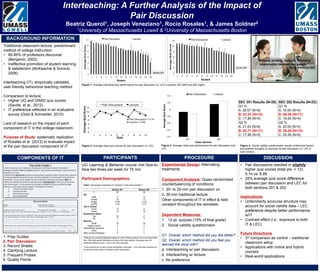
Impact of Pair Discussion in Interteaching Method
- 1. Interteaching: A Further Analysis of the Impact of Pair Discussion Beatriz Querol1, Joseph Veneziano1, Rocío Rosales1, & James Soldner2 1University of Massachusetts Lowell & 2University of Massachusetts Boston UG Learning & Behavior course met face-to- face two times per week for 75 min. Participant Demographics: PARTICIPANTS Traditional classroom lecture: predominant method of college instruction. • 80-85% of professors discourse (Benjamin, 2002) • Ineffective promotion of student learning & satisfaction (McKeachie & Svinicki, 2006) Interteaching (IT): empirically validated, user-friendly behavioral teaching method Comparison to lecture: • Higher UG and GRAD quiz scores (Saville, et al., 2012) • IT preference reflected in an evaluative survey (Goto & Schneider, 2010) Lack of research on the impact of each component of IT in the college classroom. Purpose of Study: systematic replication of Rosales et al. (2012) to evaluate impact of the pair discussion component of IT. BACKGROUND INFORMATION Figure 1. Average individual quiz performance for pair discussion vs. LEC in section 201 (left) and 202 (right). DISCUSSION • Pair discussions resulted in slightly higher quiz scores (total pts. = 12): 9.14 vs. 8.99 • 25% average quiz score difference between pair discussion and LEC for both sections 201 & 202 Implications • Unfamiliarity w/course structure may account for social validity data – LEC preference despite better performance w/IT • Contrast effect (i.e., exposure to both IT & LEC) Future Directions • 3rd comparison as control – traditional classroom setup • Applications with online and hybrid courses • Real-world applications COMPONENTS OF IT PROCEDURE Experimental Design: Alternating treatments Component Analysis: Quasi-randomized counterbalancing of conditions: 1. 20- to 25-min pair discussion vs. 2. 30-min traditional lecture Other components of IT in effect & held constant throughout the semester. Dependent Measures: 1. 12-pt. quizzes (19% of final grade) 2. Social validity questionnaire Q1. Overall, which method did you like better? Q2. Overall, which method did you feel you learned the most with? a. Interteaching w/ pair discussion b. Interteaching w/ lecture c. No preference Figure 2. Average class quiz scores for pair discussion vs. LEC. Figure 3. Average class quiz performance for pair discussion and LEC. 1. Prep Guides 2. Pair Discussion 3. Record Sheets 4. Clarifying Lecture 5. Frequent Probes 6. Quality Points Table1. Demographic information for students in both class sections1,2 Section 201 Section 202 n 29 26 Sex Male 5 13 Female 23 13 M Age 21.66 21.38 M GPA 3.25 3.37 Year in School Junior 13 8 Senior 16 18 Employment Status Yes 26 21 No 3 4 Ethnicity White 22 20 Hispanic/Latino 4 3 Black/African-American 1 1 Asian 2 1 Native American/Alaskan 0 1 1 Although we conducted statistical analyses on each of these measures, we do not report them here. Other than gender distributions for each of the class sections, the groups were not significantly different (all ps > .05) on any of the measures. 2 A few students did not report certain demographic information. Thus, the totals sometimes do not equal the total number of students in each class section. 8.2 8.4 8.6 8.8 9 9.2 9.4 201 202 AverageQuizScore Class Section Pair Discussion Lecture Figure 4.. Social validity questionnaire results: preference toward and positive thoughts on learning via pair discussion vs. LEC in each section.
